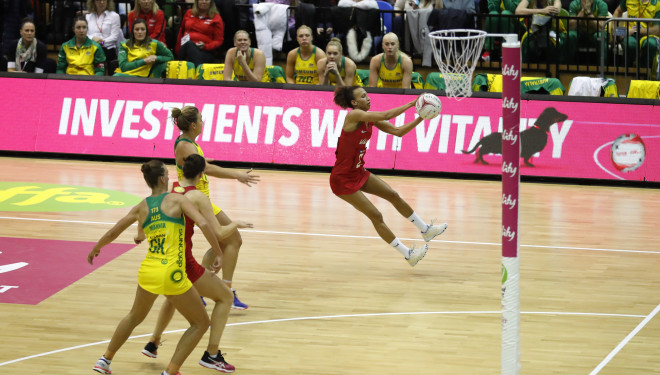
LONDON, ENGLAND - JANUARY 20: General action during the Vitality Netball International Series match between England Vitality Roses and Australian Diamonds, as part of the Netball Quad Series at Copper Box Arena on January 20, 2019 in London, England. (Photo by Luke Walker/Getty Images for England Netball)
When some people think of netball they associate it with the sport they played at school. They remember a slow, old fashioned game with the misconception that there is limited movement required and a simple bit of throwing and catching.
In October 2018, YouGov PLC conducted a survey on behalf of England Netball which showed that 27% of adults in Great Britain still think that netball is an ‘old-fashioned sport’.
England Netball’s CEO, Joanna Adams, said she regularly receives ‘stunned’ reactions from those that attend an international match, as they see for the first time the grit, determination and pure athleticism required of the Vitality Roses; England’s senior netball team.
It’s certainly not the game we remember from high school. With the Vitality Netball World Cup just around the corner research provided by Katie Denton, the Lead Strength and Conditioning Coach at England Netball, states just how athletic a netballer needs to be to compete at that level.
During an average game, a centre position will travel around 7,984 metres in distance and all players will change direction on average every 4.1 seconds.
England’s best players can hop on a single leg up to 2.5m and triple hop up to a whopping 7.5m. Landing peak resultant forces have been found to be between 3.3 to 6 times an England player’s body weight, which they land with on a single leg, proving the athletes have to be extremely strong to stop abruptly and land from a jump at that height, force and speed.
To compete in the Vitality Netball World Cup a player has to be able to physically perform at their optimal level in potentially eight games in just 10 days, which works out as 480 minutes of match play in that time.
The profile and awareness of the sport has grown massively since the England team won the Commonwealth Games in April 2018, it was a watershed moment for the sport. Since that momentous occasion they have been selling out arenas across the country whilst winning prestigious awards, such as Team of the Year and Greatest Sporting Moment at the BBC Sports Personality of the Year Awards. However, this lack of understanding of the sport is still apparent today.
Joanna Adams said: ‘Every time that I speak to people who have watched their first England match, nine times out of 10 they tell me how stunned they are by the speed of the game and athleticism of the players. I hear this on such a regular basis, so it’s evident that there is a bit of a misconception when it comes to what it takes to be a professional netball player.
‘These athletes train incredibly hard and watching an international game is thrilling, explosive and fast-paced. We here at England Netball are working hard to demonstrate this to the public and challenge misunderstandings about this wonderful sport.
‘The sport has unequivocally grown in popularity, more people are sitting up and paying attention to it – more than 130,700 people started playing netball or more netball as a result of the Commonwealth Games gold, which is fantastic – but to get more people to interact with it and to acknowledge the players as athletes we need to get them to international or Superleague games so they can see what it takes to be an elite netballer.
Katie Denton said: ‘Building strength, power and fitness is crucial for netball as it continues to evolve into a faster and more physical game. Our athletes have very strict training programmes, alike most athletes.
‘On average our players lift up to 12-15 tonnes per week in strength sessions, spending on average around 10,000 minutes in the gym during an international and domestic league period. This is alongside around 12,000-14,000 minutes of netball training and up to 2,000 minutes of match play during an international and domestic league period.
‘It takes great strength, stamina and determination to be an elite netballer, which most people don’t realise. The high intensity movements and physicality of the game requires excellent strength and fitness to beat an opponent to the ball, frequently change direction, sprint, jump and continue to physically impact across all four quarters. Therefore, a lot of physical training on and off the court goes into it to prepare someone to play at World Cup standard.’
On top of their on-court activity, on average an elite netballer completes two – three weights sessions, one – two conditioning sessions, two recovery sessions, and three injury prevention sessions per week.
A typical weights session includes the following key components:
- Lower limb strength: Exercises predominately focused on double and single leg strength to develop an athlete’s ability to jump, land and change direction. For example: Back Squat, Single Leg Squats, Forward Lunge
- Lower Limb Power: To develop power to be able to jump higher than an opponent. For example: Vertical Jump, Box Jumps
- Force Absorption Exercises: To be able to tolerate the extremely high forces placed on the body when landing from a jump, and stopping quickly. For example: Box Landings, Single Leg Hop and Holds
- Upper body and Core Strength: To be able to physically hold off opponents. For example: Press-ups, Supine Rows, Front Plank Holds, Side Plank Holds
With the Vitality Netball World Cup taking place in Liverpool from 12-21 July, Tracey Neville and the Vitality Roses are gearing up for the challenge. The final 12 that will compete at the World Cup will be announced via England Netball’s Facebook, Instagram and Twitter channels at 12:25pm on Thursday 23rd May!








